The Gondola
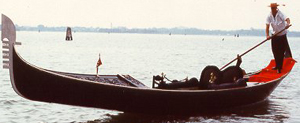
The Venetian boat par excellence, whose origin remains a mystery in
spite of extensive research into the subject.
Once, gondolas were extravagantly decorated by their wealthy and
titled owners, whose fondness for ostentation was curbed by a sumptuary
edict dictating that henceforth they should all be painted black.
|
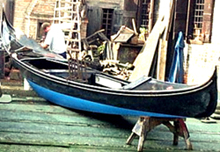
The rules for construction are extremely strict: the right side must
be 24 millimetres narrower than the left (this assymetry is know as
lai); the boat must measure 10.75 metres in length and have an internal
breadth of 1.38 metres. The gondola is used exclusively for ferrying
persons and for boat races. Eight different types of wood are used
in its construction and it is made up of over 280 different parts.
The only parts in metal are the characteristic “ferro”
of the prow and the “risso” of the stern. |
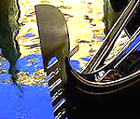
The "ferro" characterises the gondola’s prow and guarantees
the boat’s longitudinal stability, acting as a counterbalance
to the gondolier’s weight.
Popular tradition has it that the anterior “pettini” represent
the six neighbourhoods of the city and the posterior one represents
the island of Giudecca; the double “S” curve is the Grand
Canal and the lunette, positioned under a stylised doge’s cap,
is Rialto Bridge.
|
|
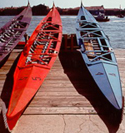 Gondolino Gondolino
Created and used exclusively for the Historical Regatta, the gondolino
first raced in 1825. It was designed specifically to make the Regatta
more competitive and exciting.
It is lighter and swifter than the gondola on which it is modelled.
The current version measures 10.5 metres from end to end, whilst its
bottom is 0.65 metres wide. |
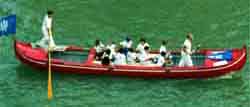 Caorlina Caorlina
Sixteen-century prints show that this working boat has faithfully
preserved all its traditional features.
Although used for fishing (the nets marking out fishing grounds are
spread with caorline da seragia), the boat serves mainly
for trasporting choice fruit and vegetables from the islands to the
city market.
 Its
distinguishing feature lies the identical shape of the bow and stern,
which are elongated and have no boom. The name of the boat suggests
that it originally came from Caorle. Its
distinguishing feature lies the identical shape of the bow and stern,
which are elongated and have no boom. The name of the boat suggests
that it originally came from Caorle. |
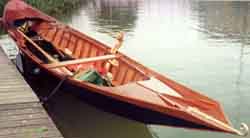 Mascareta Mascareta
A lighter version of the sandolo, used for fishing, racing and boating
excursions on the lagoon.
Its length (6-8 metres)varies according to the number of oarsmen (1-4
oars).
It appears to have been named after the masked prostitutes who often
used this type of craft. |
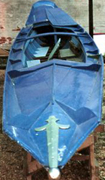 Pupparin Pupparin
A speedy vessel once used for maritime surveillance or kept by members
of the aristocracy as a town boat (barca da casada).
The poppa (stern) from which the vessel takes its name is
expecially prominent.
Rowed with up to four oars, it varies in length from 9 to 10 meters.
The slender, pointed hull and boldly pronunced bow make the pupparin
a refined and elegant craft |
 The
forcola The
forcola
This is the rowlock on which the oar rests.
Its characteristic form, the result of centuries of experimentation,
gives it the appearance of a sculpture rather than a utensil.
Nothing is left to chance: each curve, each shape, each corner has
a precise function. For example, the gondolier uses at least eight
different points of the forcola.
Each boat uses a specific forcola for the prow and another for the
stern, as they have different measurements. |

The oar
It has a flat blade and is not fixed to the forcola so that it can
be removed quickly when rowing along the narrow city canals.
It varies in length depending on the type of boat.
The oar is also used as a rudder in Venetian-style rowing and acts
as a keel for the flat-bottomed boat. |
|
|



 Gondolino
Gondolino
 Caorlina
Caorlina Its
distinguishing feature lies the identical shape of the bow and stern,
which are elongated and have no boom. The name of the boat suggests
that it originally came from Caorle.
Its
distinguishing feature lies the identical shape of the bow and stern,
which are elongated and have no boom. The name of the boat suggests
that it originally came from Caorle. Mascareta
Mascareta Pupparin
Pupparin The
forcola
The
forcola